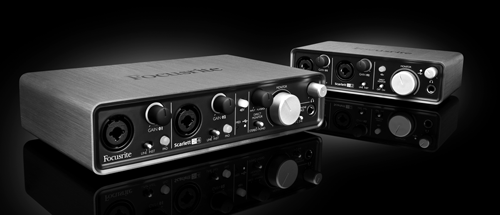
AND THE WINNER IS...
(insert drum roll here): Focusrite’s Scarlett USB interface. It comes in a variety of configurations, from the highly portable 2i2 model with the requisite two mic/line inputs and two balanced line outs, to the clearly un-portable but built-to-do-it-all 18i6 which, with eighteen inputs and six outputs, nearly makes coffee for you. Frankly we chose the smallest 2i2 not just because it met the above-mentioned criteria, but also because it’s damned cheap to buy ($149 from the dealer), built like a brick, and kinda cool-looking sitting on the lab worktables in its anodized ruby red case.
If you’ve been using Digidesign interfaces for a while then you’ve actually been using Focusrite’s mic preamps; these two companies have worked together on interface hardware for nearly a decade. And Focusrite has been a well-liked moniker in pro audio in its own right -- their Red-series of mic preamps have been favorites in studios worldwide, occupying a niche just below the über-expensive boutique models. Their Saffire series of Firewire interfaces have been popular in home studios for many years, although Firewire drivers can be fussy about the chipsets connected to them and the Saffire range got off to a rocky start as a result. But there’s no such problem with the Scarlett, which is essentially the USB 2 child of the Saffire.
Where’s the USB 3, you ask? Well, it’s not on any of the Scarlett interfaces, nor does it really need to be (although it is 3-compatible). There is more than enough bandwidth in USB 2 for up to 16 simultaneous channels of 16 bit/44.1 kHz digital audio transfer, a fact that has been proven over the past decade or so by numerous manufacturers. All we were looking for was two audio inputs and two audio outputs. And even though USB 3 connectors are (mostly) backwardly compatible, there is still not that much support for the USB 3 standard in audio today. Besides, those connectors are still a weak point; in other words they still suck (note: according to industry sources, the life-cycle of a USB2-A connector is just 1,500 plug and unplug cycles. Makes you think, doesn’t it?). Thanks, we’ll stick with USB 2 for now, and tell students to just stop unplugging things.
The A-D and D-A converters can operate at up to 24-bit word lengths and sample rates up to 96kHz, and both have a healthy A-weighted dynamic range: 105 dB for the A-D and 104 dB for the D-A, with both the actual chipsets rated at 114 dB dynamic range. The claimed frequency response is from 20 Hz to 20 kHz, plus or minus 0.1 dB. The mic preamp spec is impressive, given the price of the interface. There is one area of concern here, however; the gain range goes from +10 dB up to +55 dB. This is about 10 dB less than one would like, particularly for dynamic mics like the RE-20. It’s absolutely fine for condensers, and in my opinion the trade-off is worth it for the decreased noise floor (which specs out at 120 dB with +55 dB of gain into a 150 ohm load). So while you don’t get quite as much “oomph” in terms of mic gain, you also don’t get anywhere near as much noise as with other mic preamps at similar price points.

